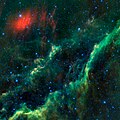astro.wikisort.org - Galaxy
The California Nebula (NGC 1499/Sh2-220) is an emission nebula located in the constellation Perseus. Its name comes from its resemblance to the outline of the US State of California in long exposure photographs. It is almost 2.5° long on the sky and, because of its very low surface brightness, it is extremely difficult to observe visually. It can be observed with a Hα filter (isolates the Hα line at 656 nm) or Hβ filter (isolates the Hβ line at 486 nm) in a rich-field telescope under dark skies.[1] It lies at a distance of about 1,000 light years from Earth. Its fluorescence is due to excitation of the Hβ line in the nebula by the nearby prodigiously energetic O7 star, Xi Persei (also known as Menkib, seen at center below it in the inset at right).[2]
| Emission nebula | |
|---|---|
 The California Nebula, as taken with an amateur telescope | |
| Observation data: J2000.0 epoch | |
| Right ascension | 04h 03m 18.00s |
| Declination | +36° 25′ 18.0″ |
| Distance | 1,000 ly |
| Apparent magnitude (V) | 6.0 |
| Apparent dimensions (V) | 2.5° long |
| Constellation | Perseus |
| Designations | NGC 1499, Sharpless 220 |
The California Nebula was discovered by E. E. Barnard in 1884.
By coincidence, the California Nebula transits in the zenith in central California as the latitude matches the declination of the object.
NASA selected the California Nebula as its Astronomy Picture of the Day on October, 22, 2022, based on a submission from an amateur astronomer taken from a ground-based telescope.[3]

Gallery
- Image of the California Nebula with amateur telescope.
- Infrared image of the nebula from WISE.
- H-alpha image of the nebula with amateur telescope.
- Picture of NGC 1499 captured in narrowband by amateur astronomer Luca Moretti
- The California Nebula (NGC 1499), in LHaRGB with amateur telescope
- California nebula NGC1499 2-7-21 captured with amateur telescope (432mm focal length 101mm aperture) (narrow band in the Hubble palette) by Randy Dunton
- California nebula with Celestron 9.25/Hyperstar by Mark Johnston
References
- "The California Nebula". Observing at Skyhound. Retrieved December 23, 2013.
- "Menkib (Xi Persei)". David Darling. Encyclopedia of Science.
- "APOD: 2022 October 22 - NGC 1499: The California Nebula". apod.nasa.gov. Retrieved 2022-10-26.
External links
- NGC 1499 at SEDS
- Menkhib and the California Nebula by the Wide-field Infrared Survey Explorer (WISE)
На других языках
[de] NGC 1499
NGC 1499 ist die Bezeichnung für einen Gasnebel im Sternbild Perseus, er wird auch als Californianebel bezeichnet. NGC 1499 liegt 36' nördlich von ξ Persei und wird wegen seiner Form auch als Kaliforniennebel bezeichnet.- [en] California Nebula
[es] NGC 1499
NGC 1499 es una nebulosa de emisión en la constelación de Perseo a 1000 años luz de distancia. Se encuentra al sur de la constelación, 36' al norte de Menchib (ξ Persei). Por su forma recibe también el nombre de nebulosa California, ya que recuerda el contorno de ese estado de Norteamérica. Aunque tiene 2,5º de longitud, debido a su bajo brillo superficial como mejor se la aprecia es en fotografías de larga exposición. A simple vista solo es posible observarla en noches especialmente oscuras.[ru] Туманность Калифорния
NGC 1499 (другое обозначение — LBN 756, туманность Калифорния) — эмиссионная туманность в созвездии Персей. Обладает красноватым цветом, а по форме напоминает[кому?] очертания американского штата Калифорния.Другой контент может иметь иную лицензию. Перед использованием материалов сайта WikiSort.org внимательно изучите правила лицензирования конкретных элементов наполнения сайта.
WikiSort.org - проект по пересортировке и дополнению контента Википедии






